PR-6171IRE Science A STEM Approach - 1st Class
You also want an ePaper? Increase the reach of your titles
YUMPU automatically turns print PDFs into web optimized ePapers that Google loves.
Energy and Forces<br />
NOW YOU SEE IT! NOW YOU HEAR IT!<br />
Lesson 2<br />
Teacher Notes<br />
<strong>Science</strong> Inquiry Focus:<br />
What are some sources of light? What is the difference<br />
between natural and man-made/artificial sources of light?<br />
Skills Development/Working Scientifically:<br />
• Questioning and predicting<br />
• Investigating and experimenting<br />
• Analysing<br />
• Recording and communicating<br />
<strong>Science</strong> Learning Outcomes:<br />
• Pupils act like scientists when they observe, ask questions<br />
and describe sources of light.<br />
• People use science in their everyday lives such as when<br />
using natural or man-made/artificial sources of light.<br />
Technology/Engineering/Mathematics Links:<br />
• Exploring characteristics of light and how it can be used<br />
for clothing design.<br />
• Using a digital device to scan a QR code and viewing a<br />
video.<br />
• Contributing to a digital T-chart.<br />
• Participating in an interactive whiteboard activity to<br />
identify sources of light.<br />
Background Information<br />
• Most of our light comes from the sun. Some objects, like<br />
our sun and often stars, give off their own light. Other<br />
things bounce back light. The moon bounces back light<br />
from the sun. It does not have its own light to give. A<br />
firefly gives off its own light. These are all natural light<br />
sources.<br />
• Artificial light is light created by people. Artificial light<br />
comes from things like light bulbs, candles, fireworks<br />
and lasers.<br />
• Additional simple information about light sources can<br />
be found at .<br />
Assessment Focus:<br />
• As a formative assessment,<br />
observe the pupil’s ability to<br />
name and describe natural and<br />
man-made sources of light during<br />
the Development and Reflection<br />
activities.<br />
Resources<br />
• Light Dancers video <br />
• Video about light energy<br />
<br />
• Sufficient copies of page 63<br />
• Online T-chart <br />
• Interactive whiteboard<br />
activity about sources of light<br />
<br />
• Computer tablets with QR<br />
code reader<br />
Viewing sample<br />
Prim-Ed Publishing – www.prim-ed.com 978-1-912760-15-2 <strong>1st</strong> <strong>Science</strong>: 61<br />
CLASS<br />
A <strong>STEM</strong> AP<strong>PR</strong>OACH

















